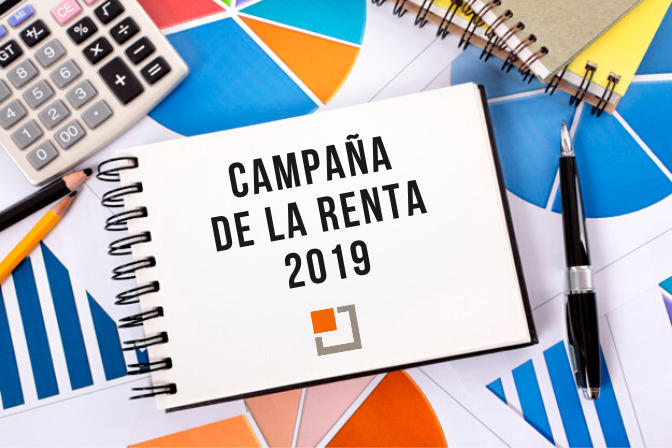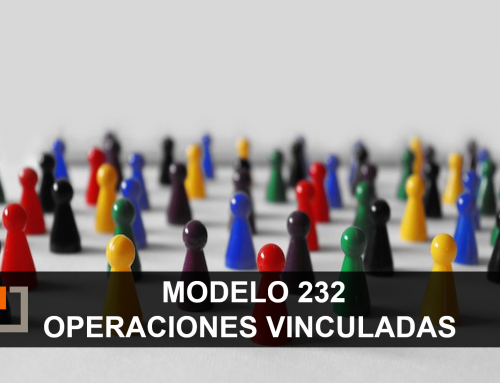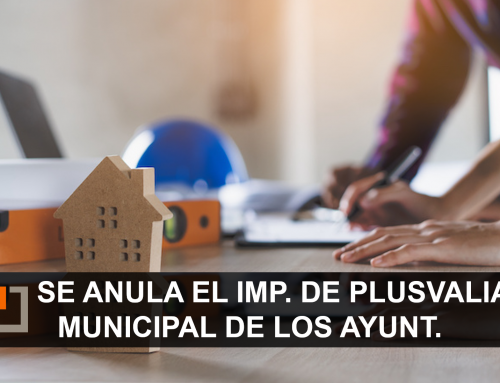Despite the state of alarm for the coronavirus COVID-19, one more year for taxpayers, we are approaching the time to account to the Treasury of our tax obligations with respect to Income and Equity, and for this purpose in the BOE of March 19, 2020, published the Order approving the models of declaration of income tax of individuals and the Tax on the Property.
The 2019 Income Campaign begins.

The coronavirus crisis has altered the economy and social life of citizens, but the annual meeting with the Treasury will remain intact, as the deadlines for filing tax returns and self-assessments are not interrupted. Thus, the campaign for the declaration of income and equity for the 2019 financial year begins today, April 1 and will run until June 30; except in the case of direct debit of declarations from 1 April to 25 June 2020, inclusive, unless only the second period is chosen: until 30 June 2020.
It is bad news that the Government has not approved a postponement of these returns to the AEAT, so that taxpayers will have to file it despite the state of alarm in Spain, and although much of the administrative and tax procedures have been affected. In fact, it is currently reported from the website of the Tax Agency that the offices of the AEAT will be temporarily closed for face-to-face care.
Deadlines, draft and self-accuracy
> Deadlines
From April 1st to June 30th, 2020.
If the payment is direct debited, the confirmation period ends on June 25, 2020.
The period for filing the declarations of the Estate Tax shall also be between 1 April and 30 June 2020, inclusive, except in the case of direct debit of the declarations which will be from 1 April to 25 June 2020, inclusive.
> Draft statement
- As in the previous campaign all taxpayers, whatever the nature of the income they have earned during the financial year (work, transferable or real estate capital, economic activities, gains and losses, as well as income allocations), they may obtain the draft declaration through the Draft/Return Processing Service (RentaWEB), after providing, where appropriate, certain information that will be requested for them for this purpose, or other information that the taxpayer may incorporate.
- The mechanism for obtaining the reference number to access the draft and/or tax data is maintained through the electronic Sede of the Tax Agency, through the Draft/Declaration Processing Service, and must enter for this purpose the Tax Identification Number (NIF) of the tax authority or taxable persons, the date of issuance or expiration of his National Identity Document (ID) and the amount of box 505 of the IRPF declaration for the 2018 financial year, “Bgeneral liquidable ase subject to tax.”
- Also as in past campaigns, the draft or tax data can be accessed through the Draft/Declaration Processing Service of the Tax Agency on the Internet, using recognized electronic certificates and the Cl@ve PIN system and through the mobile application that was launched in the previous campaign.
> Filing IRPF/IP 2019 statements
- Through draft/declaration processing service, the taxpayer can make his or her IRPF return with the Renta Web product and proceed to its submission by electronic means through the Internet, at the electronic headquarters of the Tax Agency, through the telephone, in the offices of the Tax Agency upon request of appointment, as well as in the offices enabled by the Autonomous Communities, cities with Statute of Autonomy and Local Entities for the confirmation of the draft declaration; if the return were to be entered the taxpayer may direct the income or, if not, obtain a letter of payment at the time of submission that will allow him to enter the resulting amount.
- As in the previous campaign it is no longer possible to obtain the declaration and its corresponding documents of entry or return on printed paper generated through the Draft Processing Service/Declaration of the State Agency for Tax Administration.
> payment
- In statements resulting from entering those that do not opt for direct debit as a means of payment, the taxpayer may obtain the Full Reference Number (NRC) from the collaborating entity in its offices or through e-banking services or may make the deposit through the Electronic Headquarters of the State Agency for Tax Administration using a recognized electronic certificate or the Cl@ve PIN system. In this case, the taxpayer may also make the payment through a document for admission to the collaborating entity, which must be printed and that will allow him to go in person to the financial institution to make the deposit of the same.
- In the case of taxpayers who confirm and submit the draft declaration through the mobile application, the payment of the amount of the resulting tax debt must necessarily be made in two installments, by direct debit of both.
- Splitting the payment: Taxpayers who have domiciled the payment of the first term may domicile the second term until 22 September 2019 and if they do not domicile the first period they may domicile the second term until 30 June 2020. In the case of taxpayers who, when split the payment, do not wish to domicile the second period as a collaborating entity, they must make the deposit of that period until 5 November 2020, including through the 102 model.
Top news IRPF 2019
What’s new in declaration models
1. REAL ESTATE
- It simplifies the identification of the taxpayer’s tax domicile, which this year will be made separately from the rest of the return
- All information relating to the properties owned by the taxpayer is consolidated into a single paragraph relating to immovable property. Thus, the use or uses that said property has had during the financial year will be reflected in respect of each property.
- In case of lease:
- All the concepts necessary to assist the taxpayer in calculating the return on real estate capital, particularly the amounts earmarked for depreciation, are broken down. Thus, in the next financial year the taxpayer will be able to obtain this amount directly from Web Income.
- It is expressly specific that tenants’ NIFs should only be identified in the case of a home lease for habitual housing; tenants should not be informed in the case of tourist leases or business premises.
- In relation to real estate capital returns,to expedite the processing of returns and reduce the number of requirements, a new voluntary completion Annex “D” is created, in which taxpayers may enter the VAT number of suppliers of certain expenses,as well as their amount.
- Another important novelty is the ratification of the taxdomicile, which will ask all taxpayers when accessing the different Income Campaign services. This will allow to update the addresses and improve the management of the declarations.
You will be requested to confirm your address when you consult your tax details, access the personalized services of Renta and my IRPF files, etc…
2. ECONOMIC ACTIVITIES
With regard to “Performances of economic activities in direct estimation”, to give greater legal certainty to taxable persons and to be able in the future to offer them a service to transfer data from their tax books to the model of declaration, the ratio of computable income and deductible expenses is modified. . Boxes are included to record accrued or input VAT as income or expense, in cases where the tax is a higher computable income or deductible expense in the IRPF.
Regulatory developments in IRPF 2019
1. OBLIGATION TO DECLARE
The obligation to declare by the IRPF is amended, raising the lower threshold of the obligation to declare established for the discerners of return on work in section 96 of the IRPF Act.
To this end, in 2019, the limit excluding the obligation to declare provided for in Article 96.3 of the IRPF Act for taxpayers receiving full income from work is set at EUR 14,000 in the following cases:
- Where they come from more than one payer except for the exceptions referred to in Article 96.3 of the IRPF Act.
- When they receive compensatory pensions from the spouse or annuities for non-exempt foods.
- When the payer of the returns of the work is not obliged to withhold.
- When full return on work is received subject to fixed type of retention.
For other taxpayers who obtain work income the limit for declaring for the perception of these incomes remains at 22,000 euros per year.
2. EXEMPTIONS: INDIVIDUAL SYSTEM SAVINGS PLANS
In order to ensure that the application of the exemption provided for in Section 7(v) of the IRPF Act for the performance of Systematic Savings Plans complies with the intended purpose, i.e. to address, from a fiscal perspective, the problems arising from ageing and dependence by promoting savings, it is required that life insurance contracts concluded after April 1, 2019 implement individual systematically savings plans and where reversal mechanisms, certain periods of benefit or counterinsurance formulas are established in the event of death, meet a number of requirements.
These requirements are not required or applicable to life insurance contracts concluded before 1 April 2019, irrespective of whether the annuity is made after that date.
3. DISCLAIMER FOR REINVESTMENT IN ANNUITY
As in the case of systematic savings plans and for the same reason, that is, to ensure that the application of the exemption from equity gains from reinvestment in annuity provided for in section 38.3 of the IRPF Act serves the intended purpose of promoting the planned savings by taxpayers over 65 years of age , specify the requirements to be met by insurance annuity in the case of contracts concluded after 1 April 2019 establishing reversal mechanisms, certain periods of benefit or counterinsurance formulas in the event of death. Requirements that are the same as for Systematic Savings Plans.
This does not apply to life insurance contracts concluded before 1 April 2019.
4. SPECIAL LIEN ON PRIZES OF CERTAIN LOTTERIES AND BETS
Prizes with a full amount of EUR 20,000 or less shall be exempt for the 2019 financial year.
5. WORK PERFORMANCE. APPLICABLE REDUCTIONS ON CERTAIN FULL YIELDS
By 2019, it is no longer possible to apply the transitional reduction regime to benefits received in the form of capital derived pension schemes, social security mutual funds and contingency-insured forecast plans in 2010 or earlier.
6. REDUCTION BY WORK PERFORMANCE
For the 2019 financial year, in order to reduce the tax burden on lower-income workers, both the amount of the reduction in obtaining return on work (up to EUR 5,565 per year) and the threshold for net working income to be applied (up to EUR 16,825) are increased.
In this way, taxpayers who obtain net income from work in 2019 of less than EUR 16,825, provided that they do not have income, excluding exempt income, other than those of work of more than EUR 6,500, will reduce the net return on work by the following amounts:
- Taxpayers with net income from work equal to or less than 13,115 euros: 5,565 euros per year.
- Taxpayers with net income from work between 13,115 and 16,825 euros: 5,565 euros less the result of multiplying by 1.5 the difference between the return of the job and 13,115 euros per year.
7. FURNITURE CAPITAL YIELDS FROM INTELLECTUAL PROPERTY WHEN THE TAXPAYER IS NOT THE AUTHOR
As of January 1, 2019, the withholding tax and account income rate applicable to income from intellectual property where the taxpayer is not the author is reduced from 19 to 15 per 100.
8. PERFORMANCE OF ECONOMIC ACTIVITIES IN OBJECTIVE ESTIMATION (Modules)
- Order HAC/1264/2018 of 27 November maintains for the 2019 financial year the amount of signs, indices or modules for the previous financial year.
- The thirty-second transitional provision of the IRPF Act is amended to extend to the 2019 financial year the application of the same quantitative limits excluding the objective estimation method set for the 2016 financial years, 2017 and 2018: both those relating to the volume of full yields in the previous immediate year resulting from the exercise of economic activities (250,000 euros for all economic activities , except for agricultural, livestock and forestry and EUR 125,000 for transactions in which there is an obligation to issue invoices where the consignee is an employer) and the volume of purchases in goods and services (EUR 250,000, excluding acquisitions of fixed assets)
- For agricultural, livestock and forestry activities, the exclusionary limit provided for in Article 31 of the IRPF Act applies for the volume of full yields in the previous immediate year (EUR 250,000 per year, for all its agricultural, livestock and forestry activities developed by the taxpayer) and, for the volume of purchases in goods and services, the amount of EUR 250,000 , excluding acquisitions of fixed assets, provided for in the thirty-second transitional provision in the IRPF Act and the application of which is extended to the 2019 financial year
- The overall reduction of 5 per 100 and the reduction of 20 per 100 of net income for economic activities carried out in the municipality in Lorca (Murcia)
9. ACCOUNTING AND REGISTRATION OBLIGATIONS
Until 2018, taxpayers who kept the accounts in accordance with the Provisions of the Code of Commerce were not required to keep records.
As of January 1, 2019, this exception disappears except for taxpayers engaged in business activities whose performance is determined in the normal mode of the direct estimation method. All other IRPF taxpayers engaged in economic activities have been required since January 1, 2019 to keep the books records that in each case determine IRPF regulations, even if they keep accounts in accordance with the provisions of the Code of Commerce.
10. INTEGRATION AND COMPENSATION OF RENTS INTO THE GENERAL TAX BASE AND SAVINGS
For 2019, the negative balance of the transferable capital gains of the taxable amount of the savings for the year will be offset by the positive balance of the gains and losses that are part of the taxable amount of the savings, obtained in the same tax period, with the limit of 25 per 100 of that positive balance. Similarly, the negative balance of the gains and losses of the taxable amount of the savings shall be offset by the positive balance of the transferable capital gains of the savings base, obtained in the same tax period, with the limit of 25 per 100 of that positive balance.
The same compensation and with the same joint limit shall be made with the negative balances of the transferable capital gains and the gains and losses of the taxable amount of the savings of the previous years outstanding as of January 1, 2019, after the compensation referred to in the preceding paragraph has been made.
The special procedure for the compensation of negative income derived from subordinated debt or preferred shares generated in 2014 does not apply in 2019.
11. TAXATION OF LIQUIDABLE BASES
All Autonomous Communities have approved their corresponding scales applicable to the general liquidable base.
12. FULL FEE DEDUCTIONS
1. Incentives and stimulus to business investment in economic activities in direct estimation
- New business deductions linked to certain events of exceptional public interest approved in the State General Budgets Act for 2018 that have begun their validity during the 2019 financial year are included.
- Deductions for incentives and stimulus to business investment of the Corporation Tax Act: For the implementation of job creation deductions, article 37 of the LIS requires that the procurement be made through an indefinite-time employment contract to support entrepreneurs, as defined in Article 4 of Law 3/2012 of 6 July, on Urgent Measures for Labour Market Reform.
However, these contracts have been abolished, with effect since 1 January 2019, by Royal Decree-Law 28/2018 of 28 December, for the revaluation of public pensions and other urgent measures in social, labour and employment matters, which, however, maintains the validity of those contracts that had been concluded prior to that date (1 January 2019) under the regulations in force at the time of their conclusion and those of their corresponding incentives.
As a result of the foregoing, the job creation deductions in Article 37 of the LIS may only apply to procurements made through indefinite employment contracts in support of entrepreneurs concluded before 1 January 2019.
2. Special deduction schemes for economic activities carried out in the Canary Islands.
Reserve for investments in the Canary Islands. Deductions for investments in the Canary Islands:
- The spending limits of the deduction for investments in film productions, audiovisual series and live performances of performing and musical arts performed in the Canary Islands are raised.
- On the islands of La Palma, La Gomera and El Hierro, the maximum limit on the quota established for the application in the Canary Islands of all deductions for incentives and incentives for business investment in economic activities is raised, provided that the Community state aid regulations allow it and are investments provided for in Law 2/2016 of 27 September and other laws on measures for the management of the economic activity of these islands.
- A new article 94a is added, in Law 20/1991, of June 7, amending the tax aspects of the Tax Economic Regime of the Canary Islands that states that entities that hire a worker to carry out their activity in the Canary Islands will be entitled to the enjoyment of the tax benefits that are established by the tax legislation according to the requirements established there, increasing them by 30 per 100.
13. OTHER ISSUES OF INTEREST
- The amount of the Public Multi-Effects Income Indicator (IPREM) for 2019 is set at EUR 7,519.59, in accordance with the provisions of the additional hundred and one-tenth ninth provision of Law 6/2018 of 3 July on General State Budgets for the year 2018 (BOE of the 4), since by Agreement of the Council of Ministers of 28 December 2018 the General Budgets of the State for the year 2018 are extended for 2019.
- Similarly, when the State General Budgets were extended for 2018, the legal interest of money in the 2019 financial year was set at 3 per 100.
- The average annual salary for all IRPF respondents is set at EUR 22,100 for the 2019 financial year
14. GUIDE TO THE IRPF’S AUTONOMIC DEDUCTIONS IN THE 2019 FINANCIAL YEAR
- Andalusia
- Aragon
- Principality of Asturias
- Balearic Islands
- Canary Islands
- Cantabria
- Castilla-La Mancha
- Castile and Leon
- Catalonia
- Extremadura
- Galicia
- Community of Madrid
- Murcia Region
- La Rioja
- Valencian Community

Top alerts to consider for your IRPF/IP 2019 statement
IRPF
Obligation to declare > The limit excluding the obligation to declare for taxpayers who receive full income from work in certain cases (where they come from more than one payer except exceptions, receive compensatory spouse pensions or annuities for non-exempt foods, the payer of return on work is not required to withhold or receive full income from work subject to fixed rate withholding tax) , will be 14,000 euros.
For other taxpayers who obtain work income the limit for declaring for the perception of these incomes remains at 22,000 euros per year.
In addition, within the exclusive joint limit of 1,000 euros per year provided for in the IRPF Act for attributable real estate rents, full income from non-withholding transferable capital derived from Treasury Bills and grants for the acquisition of officially protected or priced housing, the other equity gains derived from public aid are included
Maternity or paternity > benefits With effect from December 30, 2018 and for previous un prescribed exercises, they are exempt: (i) maternity or paternity benefits received from the public social security system; (ii) maternity or paternity benefits received from social security mutuals acting as alternatives to the special social security scheme for self-employed or self-employed persons, with the limit of the maximum benefit recognized by Social Security by these concepts; (iii) remuneration received during leave for childbirth, adoption or guardian and paternity, by public employees under a Social Security scheme who do not have the right to receive maternity or paternity benefits, with the limit of the maximum benefit recognized by Social Security by the appropriate concept.
Scholarships > The limits exempt from public scholarships and those granted by non-profit entities or bank foundations for the purpose of conducting a set-up study, which becomes 6,000 euros (up from 3,000 euros), are increased. This amount is raised to 18,000 euros (up from 15,000 euros) when the financial endowment compensates for transport and accommodation costs for the completion of rule studies, up to the level of master’s degree included or equivalent (before up to the 2nd university cycle). In the case of studies abroad, the exempted amount amounts to EUR 21,000 (up from EUR 18,000). If the purpose of the scholarship is to carry out doctoral studies, the exempted amount reaches 21,000 euros or 24,600 euros in the case of studies abroad.
Special levy on prizes for certain lotteries and bets > Prizes with a full amount of EUR 20,000 or less shall be exempt for the 2019 financial year.
Deliveries to employees of products at discounted prices made in company canteens, canteens or social economy (meal vouchers or restaurant checks) > The daily amount exempt from the indirect formulas for the provision of the dining service, such as restaurant tickets, food vouchers or similar documents, cards or any electronic means of payment that are delivered to the worker, is increased from 9 to 11 euros per day.
Reduction in job performance > For the 2019 financial year, in order to reduce the tax burden on lower-income workers, both the amount of the reduction in obtaining return on work (up to EUR 5,565 per year) and the threshold for net working income to be applied (up to EUR 16,825) are increased.
Deduction of housing supply and maintenance costs incurred in the development of economic activity > Self-employed persons (entrepreneurs and professionals) in direct estimation in the IRPF can deduct the costs of housing supplies partially affects economic activity, such as water, gas, electricity, telephony and the Internet, as a result of applying 30% to the proportion between the square meters of the dwelling intended for the activity relative to their total area , unless a higher or lower percentage is tested. Deductible expenses shall also be for the determination of net return in direct estimation of maintenance expenses incurred in the development of economic activity, provided that: (i) occur in catering and hospitality establishments; (ii) are paid using any electronic means of payment, and (iii) with the quantitative limits established by regulation for allowances and allowances for normal workers’ maintenance costs, i.e. in general, EUR 26.67 if the expenditure occurs in Spain or EUR 48.08 if it is abroad, amounts which are doubled, in turn, if bolted as a result of the displacement.
Activities in objective estimation (IRPF/VAT modules) > The amount of modules and net performance indices of activities are maintained for 2019 and the 5% reduction in the net yield of modules, as well as the 20% reduction in net return for economic activities carried out in the municipality in Lorca (Murcia). The application of the same quantitative limits excluding the objective estimation method set for the years 2016 to 2018 (250,000 and EUR 125,000) is extended for 2019.
Integration and compensation in the tax > base of savings Furniture capital yields are integrated with each other in the tax base of savings. If the income earned is negative, their amount will be offset against the positive balance of the gains and losses declared in the other component of the taxable amount of the savings with the limit of 25% of that positive balance. Gains and losses that are integrated into the taxable amount of savings: If the balance of the integration and compensation of such income is negative, its amount can be offset by the positive balance of the other component of the savings tax base, transferable capital gains, with the limit of 25% of that positive balance. In both cases if negative balance remains after such compensations, its amount will be cleared within four years.
The special procedure for the compensation of negative income derived from subordinated debt or preferred shares generated in 2014 does not apply in 2019.
Investment deduction in start-ups > or newly created companies Remember that the maximum deduction base is 60,000 euros and the deduction percentage is 30%.
Deduction for > rents earned in Ceuta and Melilla You can apply 60% deduction for rents earned in Ceuta or Melilla for both taxpayers residing in those territories and taxpayers who do not have their habitual and effective residence therein.
Maternity deduction > Please note that the amount of the maternity deduction may be increased by up to an additional EUR 1,000 where the taxpayer entitled to it has met in the tax period costs of custody of the child under three years of age in authorised childcare centres or children’s education centres. Unlike the general maternity deduction, taxpayers entitled to the additional increase for custodial expenses cannot ask the State Agency for Tax Administration to pay in advance, but must make the appropriate increase directly in the IRPF return.
Deductions by large family or persons with disabilities in charge > Remember the amount of the deduction (for being an ancestor, or an orphaned brother of a father and mother who is part of a large family, or because he is a legally separated ancestor, or without a marriage bond, with two children without the right to receive annuities for food and for which he is entitled to the entire minimum for descendants, up to 1,200 euros per year increasing this amount by 100% in the case of large families of special category) up to 600 euros per year per year each child who is part of the large family that exceeds the minimum number of children required for that family to have acquired the status of large family of general or special category, as appropriate.
The deduction by the spouse not legally separated with a disability shall also apply, provided that he does not have annual income, excluding exempt income, more than 8,000 euros or generate the right to the deductions provided for a disabled or ascendant with a disability entitled to the application of the minimum, up to 1,200 euros per year.

ESTATE TAX
In view of this 2019 exercise, we must keep in mind the following issues:
- Taxable persons whose tax share, after applying the deductions or bonuses that may be made, result in entry, or where, not in this circumstance, the value of their goods or rights exceeds 2,000,000 euros are applied. Persons who died in 2019 before December 31 are under no obligation to file for this tax.
- The limit of the exemption from the usual home is maintained up to a maximum amount of 300,000 euros. It should be remembered that this amount is for each taxpayer, so a marriage that owns a home acquired in profits will not be taxed for it if its value does not exceed 600,000 euros.
- The taxable amount shall be reduced to the exempted minimum approved by the Autonomous Community and, if the Autonomous Community has not approved the exempted minimum, the taxable amount shall be reduced by EUR 700 000.
- Rates: in general the state applies, with 8 tranches and rates from 0.2 to 2.5%, except in some Communities, such as Asturias, Illes Balears, Cantabria, Catalonia, Extremadura, Galicia, Murcia and Comunitat Valenciana, which have their own rate.
- Also keep in mind the tax quota bonuses approved by each Autonomous Community. For example, Madrid has a 100% bonus and Rioja is 75%.
The following alerts should be taken into account for review:
- Income ownership: it is common for interest or earnings and their respective withholdings to have formal ownership (in the financial institution or manager) that does not correspond to legal and tax ownership. For example, it may be in the name of one of the spouses and belong to both (to the earnings society) or it may be in the name of a spouse and his or her daughter or child and may be just the other spouse.
- Personal and family circumstances: birth of children, marriage, separation, adoption, death of a family member, annuities for food, the disability we have recognized since 2018, etc.
- Form of taxation: we must examine whether joint or individual taxation is best for us.
- Work performance: The draft does not subtract expenditure from trade union, school or legal defence fees. It will also be necessary to see, in the case of Employment Regulation Files (ERE) whether only non-exempt compensation and reform amendments are taxed. On the other hand, please note that it is limited to the amount of EUR 180,000 for each year of service provided for the purpose of determining the amount of compulsory compensation, exemption from redundancy payments. That limit shall not apply to compensation for redundancies or dismissals which occurred prior to 01-08-2014 or to redundancies which occur from that date when they derive from an approved employment regulation dossier, or a collective redundancy in which the opening of the consultation period had been communicated to the labour authority prior to that date.
- Conferences and courses: It is relatively common for the payer of these incomes to impose them as professional activities and have been obtained as income from work. The error, among other effects, will prevent us from declaring through the draft. It may also happen the other way around, which are performances of activities and impose them on us as work.
- Company administrators: The draft may not include such payments to Social Security as deductibles for income from work earned from society.
- Contributions to political parties: there is a right to a deduction and the AEAT does not have that data under control.
- Real estate income allocations: property may be taxed 100% on only one of the co-owners and do not include the actual percentage of ownership of each taxpayer.
- Parking spaces or storage room: as they have different cadastral reference, it may be that, even if we have acquired it with the house, we will be charged an income for its use.
- Deduction for home acquisition, much of which the draft will surely not cover the following aspects:
- Expenses inherent in the acquisition: notary, registration, commissions, taxes, etc.
- Quantities met to promoter or builder. Deduction of payments while the usual future home is under construction.
- Remember that since 2013 the deduction for home acquisition has been abolished, although a transitional regime is maintained for acquisitions made prior to 01-01-2013.
- Autonomic deductions:
- Personal and family circumstances: birth, etc.
- Acquisition of textbooks
- Environmental investments
- Rent by young people
- Women or young entrepreneurs
- Acquisition of second residence in rural area (young people)
Not required to file a return with the result of entering (by mistake in withholdings).
- If we are entrepreneurs or professionals, we will have to square the income and expenses of the economic activity with other models presented such as VAT, withholdings, declaration of transactions with third parties, etc.
- We need to check whether we have performed related transactions in the exercise, which can happen if we are partners or company administrators or if we are spouses or relatives of partners or administrators. We have to be careful to assess the transactions carried out with the companies to which we are linked to market value.
- Check the economic regime of marriage, the civil situation of the declarant, identify the members of the family unit as well as others who are entitled to reductions, deductions or the application of the family minimum.
- Also check the declarations of previous years, or, where applicable, request for returns.
- It is also necessary to check whether or not there is an obligation to declare byIRPF, and whether it constitutes a household to opt for individual or joint declaration.
- If we are required to file the Estate Tax, we must provide that such a return may only be filed online and, in that case, the IRPF can also be filed by telematics only.
In addition, the following documentation should be taken into account:
- Certificates: work, unemployment, disability, withholdings issued by tenants of rented premises, yields and withholdings of bank accounts, deposits, insurance, dividends or purchases of bonds and promissory notes, income and withholdings of agricultural and professional activities, sale of securities, prizes, contributions to pension plans, mutuals or loans.
- Books records of business and professional activities.
- If they take them, ledgers.
- If you are a common member in a Community of Goods that carries out economic activities or your income exceeds 3,000 euros / year, the notification issued by that community in which information about the income of the entity attributed to it must be included, specifying different types of income, the basis of the deductions that correspond to it and the amount of the withholdings attributable to it.
- If you are carrying out an economic activity, it is appropriate to keep in mind the tax returns for the 2019 financial year: VAT, quarterly declarations and annual summary; withholdings, quarterly self-accuracies and annual summary; 347 model, 720 model, etc.
- Proof of income and expenses corresponding to real estate capital income.
- Receipts of the Property Tax, in them we will find proof of the expense of taxes of the rented property, or expenses in the professional activity if the property is affected by it or, at least, the Catastral Reference Number that the Administration will require us to enter for the usual home and other properties.
- Proof of the acquisition and disposal of goods that may have given us gains or losses.
- Statements from previous exercises.
Consider the documentation you need to collect in order to make the 2019 Income Statement:
- Tax data provided by AEAT.
- Identification data: ID, NIF, family data, etc.
- Certificate of withholdings on wages (work).
- Certificate of benefits and withholdings (pensions and unemployment).
- Certificate of bank accounts (current accounts, notebooks and installment deposits).
- Certificate of income in account-housing.
- Receipt of the Property Tax (houses, premises, garages).
- Invoices and receipts for the purchase of housing (habitual housing).
- Housing loan certificate (habitual home or for rent).
- Receipts of rents charged and expense bill (houses, premises, garages).
- Certificate of withholdings on rentals of premises (commercial premises given for rent).
- Writing of sale or donation of real estate (sale of houses, premises, garages).
- Certificate of quoted securities (shares, public or private debt).
- Certificate of unlisted securities (shares and shares).
- Certificate or “position status” of investment funds (FIM, FIAMM, SIM, SICAV).
- Certificate of life, retirement and sickness insurance (including those signed up for a home loan for the purchase of regular housing).
- Certificates of invalidity and accreditation of the need for adequacy works in the housing of the disabled.
- Pension plan certificate.
- Ledgers (entrepreneurs and professionals).
- Printed of mandatory tax returns (employers and professionals).
- Professional retention certificates.
- Receipt of donations to charities.
If you have any questions or need any clarification with the presentation of the 2019 Rent, you
can contact
any of our advisors so that we can help you.









